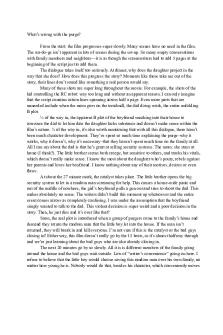Market Coverage & Intensity- Mark 457 PDF

| Title | Market Coverage & Intensity- Mark 457 |
|---|---|
| Author | Philippe Lacroix |
| Course | Marketing Channels |
| Institution | Concordia University |
| Pages | 2 |
| File Size | 36.8 KB |
| File Type | |
| Total Downloads | 22 |
| Total Views | 115 |
Summary
marketing coverage and intensity...
Description
Market Coverage & Intensity: The market coverage strategy refers to the three categories of coverage which are, differentiated, undifferentiated and concentrated coverage. Seeing as our marketing efforts revolve around offering fresh and organic produce at discount prices, the market coverage that best suites the strategy is differentiated. A niche targeting will help enforce the brand position of good for you high quality foods, all while appeasing the wants of the current target market of discount shoppers that are known to Super C. In terms of channel intensity decisions, some factors must first be determined in order to define the desired intensity level. The fist factor to examine is that of channel competition. Keeping a high intensity in this aspect will help Super C hold control in its channels. Being a super market, and holding many products, Super C consequentially deals with many competitors within its channel networks. To maintain a competitive advantage, they will need to maintain a high intensity with their Rooftop Farming Operation. The Second Factor is the product category. The product offered by our marketing proposition is falls into multiple categories. These include, food, fruits and vegetables, organic produce, local produce and discount products. Seeing as these products fall in between convenience and specialty, the are found to be shopping goods. In this respect an intermediate level of selectivity is most appropriate for the categories that the products are involved in. The third Factor being the brand strategy, is as previously mentioned positioned in more of a niche segment of the market and therefore requires a higher level of
selectivity for distribution. Leading to the fourth contingent point channel influence. By using a dual distribution system from both producing it’s own produce as well as using other distributors, Super C will maintain a degree of independence within it’s channels which also touches on the fifth factor, dependence balancing. The sixth factor that influences the channel intensity is opportunity cost. This opportunity costs incorporates the amount of produce grown through the operation versus what could be sold if produce was outsourced. However, this must also be measured in relation to the new markets reached with the marketing effort. Factor seven concerns transaction costs. This may be the most impactful factor in terms of channel intensity decisions. Seeing as there will be great start up costs, in order to install the rooftop farms and grow operations to a point where economies of scale may begin to take effect, again selective distribution would be prudent. In creating these new channels, Super C will also have to take into account the inventory holding costs and additional operational expenses. The final factor looks at other manufacturer’s strategies. Super C already has strong brand equity in Quebec as previously stated but is in a saturated market and therefore should still look towards competitor’s strategies such as LUFAFARMS and other grocers like IGA and Provigo. In Conclusion, the proposed market coverage strategy is differentiated due to the niche position of the produce, being locally grown, organic and at discount prices. In addition it is recommended that Super C goes with a Selective Distribution for their promotion....
Similar Free PDFs

457 2611 - 457
- 1 Pages

457 1211 - 457
- 1 Pages

Intensity transformations
- 95 Pages

The purge - script coverage
- 3 Pages

Accenture Liquidity Coverage Ratio
- 24 Pages

Mark up and mark down
- 3 Pages

The Lexical Coverage of Movies
- 22 Pages

LEA 1 11-Midterm Coverage
- 16 Pages

Market & Market Failure
- 2 Pages

Mark Notes
- 1 Pages
Popular Institutions
- Tinajero National High School - Annex
- Politeknik Caltex Riau
- Yokohama City University
- SGT University
- University of Al-Qadisiyah
- Divine Word College of Vigan
- Techniek College Rotterdam
- Universidade de Santiago
- Universiti Teknologi MARA Cawangan Johor Kampus Pasir Gudang
- Poltekkes Kemenkes Yogyakarta
- Baguio City National High School
- Colegio san marcos
- preparatoria uno
- Centro de Bachillerato Tecnológico Industrial y de Servicios No. 107
- Dalian Maritime University
- Quang Trung Secondary School
- Colegio Tecnológico en Informática
- Corporación Regional de Educación Superior
- Grupo CEDVA
- Dar Al Uloom University
- Centro de Estudios Preuniversitarios de la Universidad Nacional de Ingeniería
- 上智大学
- Aakash International School, Nuna Majara
- San Felipe Neri Catholic School
- Kang Chiao International School - New Taipei City
- Misamis Occidental National High School
- Institución Educativa Escuela Normal Juan Ladrilleros
- Kolehiyo ng Pantukan
- Batanes State College
- Instituto Continental
- Sekolah Menengah Kejuruan Kesehatan Kaltara (Tarakan)
- Colegio de La Inmaculada Concepcion - Cebu





